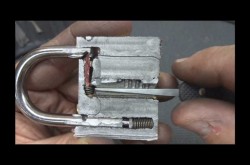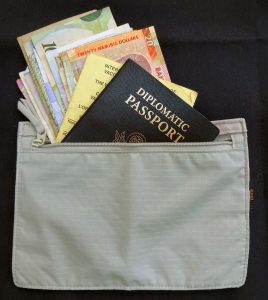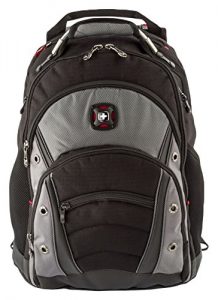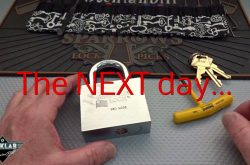Take the time to secure your passport and shot record inside your Pacsafe bag and the double lock it inside your hotel room safe.
I’ve spent the biggest part of my life in “bad places”, either as part of my job or while in the military. I grew up in New Delhi, Athens, Frankfurt, and Bangkok. When I turned 18 I came back to the U.S. to attend college, then joined the military, which sent me back overseas to Germany, Italy, Johnston Atoll, Turkey, Greece, Iraq, Afghanistan, Saudi Arabia, and a lot of other worse places. When I retired from the Army I took a job with the government that requires almost constant worldwide travel to “bad places”. That’ll be our generic term from this point forward. Yeah, they’re exciting and fun places to go, but a bit off the beaten path. Still, some of the most exciting things on Earth can be found in “bad places”, and many people go on “adventure vacations” to them so I thought you might benefit from my lesson learned. Everyone’s been to Aruba, but how many of us can say we’ve survived Bujumbura during a coup, been shot in Sudan, bitten by a snake in Botswana, or in a helicopter crash in Mozambique? THOSE are truly bad places. But they were fun and my memories are vivid.
Traveling to “Bad Places”… and Back
 Passports. Most of us realize the importance of our passports for international travel, but fail to secure it once we arrive at our destination. You shouldn’t just stash it in your suitcase or backpack and leave it back in your room. Having a wire reinforced security bag, commonly called a Pacsafe, is a really good investment. Take the time to secure your passport and shot record inside your Pacsafe bag and the double lock it inside your hotel room safe. While this isn’t perfect security, it’s better than leaving it hidden under your mattress. Some hotels offer to secure your stuff in a centralized safe at the front desk. I don’t recommend using those for two reasons: All of the desk personnel have access to your items; and they know your exact comings and goings – giving them plenty of time to look at your stuff.
Passports. Most of us realize the importance of our passports for international travel, but fail to secure it once we arrive at our destination. You shouldn’t just stash it in your suitcase or backpack and leave it back in your room. Having a wire reinforced security bag, commonly called a Pacsafe, is a really good investment. Take the time to secure your passport and shot record inside your Pacsafe bag and the double lock it inside your hotel room safe. While this isn’t perfect security, it’s better than leaving it hidden under your mattress. Some hotels offer to secure your stuff in a centralized safe at the front desk. I don’t recommend using those for two reasons: All of the desk personnel have access to your items; and they know your exact comings and goings – giving them plenty of time to look at your stuff.
A few of you might suggest carrying your passport everywhere. That’s OK if you’re visiting countries like Switzerland (of course your security concerns in places like that are much lower), but not in truly nasty places where street crime is not only possible, but probable. Instead, make a Xerox copy of your passport and shot record before leaving home and keep it in your hand luggage. When you’re out and about in your destination country, carry the copy, not the original. Having a copy also makes it much easier to get a replacement if you ever do lose your original.

If you DO lose your passport or have it stolen, notify your local embassy or consulate immediately. Obtaining another passport is a laborious, time consuming process so be prepared to spend some extra time in the country as your paperwork is verified. Not every country has an embassy in every country, so check this before you leave home. Many of us are “represented” by other countries’ embassies. For example, Switzerland is often entrusted to represent many different countries and issue passports on their behalf. Of course, this will add a layer of difficulty and take additional time if you ever lose your passport. The Xerox copy of your passport information will expedite the process.
Shot Records. The international yellow shot record is a dinosaur. Go to your doctor before leaving home and ask them to print out your shot record. Make several copies and give one to a trusted friend. Fold one up and put it in your suitcase and keep a copy in your passport. Use a highlighter to highlight your Yellow Fever vaccination. You must have this to enter any African country and must produce it on demand upon arrival, so do NOT pack your only copy in your checked luggage. If you cannot produce proof of your yellow fever they will insist on giving it to you. The very last thing you want is to receive a shot in an African airport. Given that option I recommend you remain in the terminal and return to your departure country without accepting the inoculation. If you find yourself in that situation, hand over a 20 Euro note with your shot record. It may give you a 50/50 chance of getting a casual wave-through. It is not a bribe. It is “compensation for enhanced scrutiny”. Just check your yellow fever before leaving home and avoid all the hassle.
Credit Card. You’ll need a credit card if you don’t already have one. If you DO have one, I’d still recommend getting another temporary card specifically for the trip. At the end of the trip, cancel the card. That way none of your real credit cards are at risk, and by cancelling the card there is no chance of further exploitation. Nice and clean.
If you DO use your personal card to travel to high risk places, be SURE to carefully check your statement every single month for as long as you own the card. I’ve had charges appear a year or more after returning from a trip – and reversing them is always a pain in the rear. Nowadays my bank understands my “special needs” and generates temporary cards within a day or two of my request. Another option is the debit card, but these are not accepted in many places. A final option is traveler’s checks. These are GREAT in Europe, but never an option in bad places. To them, traveler’s checks are worthless pieces of paper.
Cash is King. Yes, you have a brand new, unused credit card. Still, it’ll be denied at least 25% of the time, usually in some backwater hotel at 0200 hours when nobody at your bank is answering the phones. Always carry cash. I always take enough cash to pay for my hotel room – and never have less than $2,000 in my pocket when departing on a trip. Remember though, if you lose cash it’s on you. Invest in a money belt and use it. Go to the bank several days before your scheduled departure to get your cash just in case something has been switched off with your credit card.
 When you pick up your cash always ask the bank teller for new bills. Worn, torn or pre-2005 bills are not accepted in Africa or Central Asia. Always get a couple hundred dollars of $20 bills so you’ll have the flexibility to change a quantity less than $100. Don’t depend on cash machines because they always fail or deny your card when you need them most. Don’t buy currency from those little kiosks in the airports – they’re all rip-offs and sometimes take up to a 20% fee. Instead, pay with dollars or Euros, and later exchange for local currency at the Embassy or in your hotel. Never buy more than $100 worth of local currency at a time unless you’re positive you’re getting a good rate. Watch out for transaction fees – that’s how they rip you off: a GREAT exchange rate but an astronomical transaction fee. Embassies usually have pretty competitive rates. Never use money changers on the street because they’re smarter than all of us put together. Never engage in black market currency exchanges, even when the exchange rate is five times the “official” rate. Authorities often use this as a way to extract heavy fines from foreigners engaged in “illegal currency transactions”. Some even confiscate the entire amount if they catch you. Instead, get your driver or hotel concierge to do it when you’re not around to get busted. Remember to tip him for his trouble.
When you pick up your cash always ask the bank teller for new bills. Worn, torn or pre-2005 bills are not accepted in Africa or Central Asia. Always get a couple hundred dollars of $20 bills so you’ll have the flexibility to change a quantity less than $100. Don’t depend on cash machines because they always fail or deny your card when you need them most. Don’t buy currency from those little kiosks in the airports – they’re all rip-offs and sometimes take up to a 20% fee. Instead, pay with dollars or Euros, and later exchange for local currency at the Embassy or in your hotel. Never buy more than $100 worth of local currency at a time unless you’re positive you’re getting a good rate. Watch out for transaction fees – that’s how they rip you off: a GREAT exchange rate but an astronomical transaction fee. Embassies usually have pretty competitive rates. Never use money changers on the street because they’re smarter than all of us put together. Never engage in black market currency exchanges, even when the exchange rate is five times the “official” rate. Authorities often use this as a way to extract heavy fines from foreigners engaged in “illegal currency transactions”. Some even confiscate the entire amount if they catch you. Instead, get your driver or hotel concierge to do it when you’re not around to get busted. Remember to tip him for his trouble.

Currency Management.
You notice I recommend you only exchange $100 at a time unless you KNOW you’ll be using it. The currencies in the places I’m referring to are pretty much valueless outside of that country. If you leave holding a whole bunch of it you’ll never be able to change it back into “real” money, i.e. Euros, Pounds or Dollars. You’re stuck with it forever or at least until you go back to that country. A few Francophile countries use the CFA, but almost every other African nation has its own currency except for Liberia. Liberia uses U.S. Currency. The same is true for Central Asia and much of South America, although Ecuador and Panama both use U.S. Currency as well. One of the ways to handle this is to have a blow-out dinner at the hotel the last night of the trip. Everyone pitches in all their currency and eats and drinks until it’s all gone. Or, you can just bring it all home but after a while you’ll run out of places to store it all. Oh yeah, most of the local currencies are very well used and stinks like old sweat socks.
Frequent Flier Accounts. Not too many years ago this was a really difficult subject and you needed to devote a lot of time to managing all of your accounts. After flying several million miles I’ve almost broken the code. You only need to sign up for three airline frequent flier accounts: OneWorld, Skyteam, and Star Alliance. Virtually all airlines belong to one of these three so I recommend you join them all. You’ll quickly accumulate frequent flier miles and earn some kind of “elite” status. This doesn’t mean what it used to… Basically it means you can use the airline’s lounge but only when traveling internationally. You might get a free drink or two but don’t count on it.
So, how should you use your huge pile of accumulating miles? Well, they have a monetary value. I’ve calculated that each mile has an approximate value of only 2.5 cents. A round trip to Frankfurt from DC will earn you about 8000 miles, which has a value of about $200. Now, suppose you want to fly to Omaha and United wants $525 for the ticket. To earn that ticket, you should be able to get it for 21,000 miles, or 2.625 round trips to Frankfurt. It doesn’t work that way. They want 40,000 – 50,000 miles for that ticket so the actual value to you is between 5 – 6.25 round trips to Frankfurt. They’re really charging you between $1000 – $1250 for that $525 ticket! What a rip-off. What I’m saying is that giving your miles away for tickets is really stupid. The question remains though: how do you spend your miles?
 Upgrades. This is the only way to intelligently use your miles. After you reach an elite level (not before) you should apply for an upgrade on every single flight you take. Yes, there’s another secret which I’ll get into next, but this is how you get the most value from your hard-earned frequent flier miles. Why after reaching elite status? Because before you earn elite status you earn 1 mile for every mile flown. If you use any miles they subtract it from your balance. After you reach elite status, you earn 2 miles for every mile flown and rack up miles much more quickly. You’ll have more to throw around on upgrades.
Upgrades. This is the only way to intelligently use your miles. After you reach an elite level (not before) you should apply for an upgrade on every single flight you take. Yes, there’s another secret which I’ll get into next, but this is how you get the most value from your hard-earned frequent flier miles. Why after reaching elite status? Because before you earn elite status you earn 1 mile for every mile flown. If you use any miles they subtract it from your balance. After you reach elite status, you earn 2 miles for every mile flown and rack up miles much more quickly. You’ll have more to throw around on upgrades.
When making your flight reservations use www.seatguru.com and see details about the seat you are thinking about. Chances are your travel agent chose randomly and you probably got stuck in a center seat. Seatguru will show you a map of the aircraft with color-coded seats. Some seats look good but Seatguru knows better. Some seats don’t recline, or have an entertainment box underneath. Seatguru keeps track of all that stuff. Here’s what Seatguru doesn’t tell you: Bulkhead seats are bad. Yeah, Seatguru says they’re green. They’ve got plenty of legroom most of the time. But, and this is a big one, you have about a 100% chance of getting bumped out of the seat after boarding by somebody traveling with a baby. The bulkhead is the only place to fasten a crib and baby bearers know this. Even though you reserved the bulkhead seat months ahead of time, you get bumped by the first baby bearer that comes along. You’ll quickly find yourself shoehorned between two fat men in row 67. If you argue the stewardesses will have you arrested for interfering with the flight crew. Life ain’t fair. Suck it up.
Let’s say you’re still determined to go to Omaha and recognize there’s a better way. Visit a ticket discounter like Priceline or Travelocity and you’ll find that the going rate to Omaha right now is $187 for a non-refundable discount ticket. Buy the ticket and then immediately apply for an upgrade. You’ll end up getting a business class ticket for $187! THAT’S the way to travel!
 Carrying your Stuff. Over the years I’ve carried every conceivable bag, ranging from a canvas map bag, a bicycle messenger bag, a hard-shell briefcase, a nylon over-the-shoulder “tote”, a leather folio, a pelican case, and a number of backpacks. Of these, the backpacks won out in terms of comfort, capacity, and security.
Carrying your Stuff. Over the years I’ve carried every conceivable bag, ranging from a canvas map bag, a bicycle messenger bag, a hard-shell briefcase, a nylon over-the-shoulder “tote”, a leather folio, a pelican case, and a number of backpacks. Of these, the backpacks won out in terms of comfort, capacity, and security.
Finding the right backpack was another story. Since I carry my laptop and charger, back up hard drive, camera, GPS, some medical gear, my in-flight orange bag, as well as some other junk it had to have a good capacity. I also wanted it to stand up by itself to protect the laptop from damage and stay clean. After trying about 10 different backpacks I settled on the Swiss Army “Synergy” ($85 @ Micro Center).
I’m sure you have your own proven system so won’t bore you much longer. Whichever carry-on you chose remember where you’ll be traveling to. Here are some things you should be looking for:
- It should be secure-able in some way. I use two TSA locks and keep them on all the time. This keeps thieving hands out during your flight and it’s in the overhead and keeps the maid out when you leave it in your room.
- Easy to carry long distances.
- Have enough room to hold all your junk, to include an extra set of underwear, pants, socks and your shaving kit. Whatever you need to survive when they lose your suitcase for 1-2 days, which is absolutely normal.
- NOT look like an assault pack or have any unique markings, like flags or military badges.
- Have a strong handle. Three of my backpack’s handles tore off.
- Good construction and double-sewn straps. Four or five packs failed when one of their carrying straps ripped off or zippers failed.
- Should stand up by itself. Sounds trivial but it’s really irritating to have a bag that’s constantly falling over and getting dirty.
- Waterproof on the bottom. You’ll be setting it down in some really nasty places.
- Be compressible. My favorite bag was the small pelican case but it was a bitch to find overhead compartment space to fit it into. It looked cool though.
Aircraft Assaults. If you’ve been upgraded to business or first class, board whenever you want. If you’re still stuck with an economy ticket your timing to board is important. You’ll need to observe the enemy (other passengers) to make the best decision about when to make your assault (board). While you’re surveilling your adversaries, pop an Advil. Just do it. Trust me.
 In the Africa and the Middle East everyone carries every single thing they own onto the aircraft: goats, overstuffed couches, fireworks, bed mattresses, steamer trunks, Persian carpets, everything. When this happens you’ll have to suck it up and board early to stake out some overhead bin space. The last thing you want is your backpack underfoot for a 9-hour flight.
In the Africa and the Middle East everyone carries every single thing they own onto the aircraft: goats, overstuffed couches, fireworks, bed mattresses, steamer trunks, Persian carpets, everything. When this happens you’ll have to suck it up and board early to stake out some overhead bin space. The last thing you want is your backpack underfoot for a 9-hour flight.
In more civilized airports everyone might be carrying a magazine. A purse at most. Under those circumstances a tactical gamble is worth it to avoid the boarding crush. Take your time at the bar, finish your beer and board last.
My personal strategy is to not lock myself to my backpack. If you plan ahead, you can separate out the things you’ll need during the flight. I have an orange bag I stole from an Army hospital. It holds everything I need for the flight: iPod, noise cancelling headphones, extra batteries, Kleenex, toothbrush, eye mask, antacid, pens, eye drops, passports and shot record, all my frequent flier cards, and a small LED flashlight (on the zipper). Most importantly, a plastic bag with more Advil and a couple Ambien. While in line I also pull out my iPad so I have everything I need in my hands. As I’m moving towards my seat I begin looking for overhead space about 10 rows before my assigned seat. I’m also looking ahead to see if there might be something closer, but if it looks questionable I just fling my backpack into the first available spot and keep moving. When I get to my seat I may discover some space. I throw my orange bag, shoes, blankets and pillow in the spot to hold it. Then at the first opportunity I grab my backpack and move it to the spot, placing the orange bag at my feet. If I find no space, I just leave the backpack where it’s. It’s a sealed aircraft. There’s nothing of real value in the backpack anyway (it’s all in my money belt or the orange bag). Besides, there are TSA locks on my backpack’s zippers, remember?
How to score a better seat AFTER boarding. After you sit down keep your junk on your lap and look around for empty seats. Make note of where the babies, children, and yakkers are sitting so you can avoid them. Watch the flow of incoming passengers and try to judge if everyone has boarded or not. A clue is what the stewardesses are doing. As soon as they start moving around, counting people, putting away extra pillows, or something like that – it’s time to act. Don’t be bashful or timid in this next move. As soon as you believe everyone is boarded jump up and grab the seat you’ve scoped out. Act like you belong there. I’ve never been busted for doing this.
My new rule is I never swallow an Ambien until the aircraft’s wheels leave the runway. So far it’s worked.
Sleep Tactics. As soon as possible put in some ear phones. Don’t engage your seatmates in conversation. If they try it with you put an exasperated look on your face while removing your ear phones and say “WHAAAAATTTTTttttt?” every time they do it. If my seatmate is insistent I have a piece of string in my orange bag that I hang out of my mouth and start humming. Drool and blowing boogers is phase 3 but I’ve not yet had to go that far. Just don’t talk to strangers, you will always regret it. Most airline passengers are zombies but I did once have a beautiful Swedish girl ask to hold my hand during takeoffs and landings. I still dream about that flight… Life was good that day.
Ambien is critical to life. Think of it as a food supplement or vitamin. If you’re a health nut and don’t like “putting drugs into your body”, please give your Ambien to me. If you’re normal instead of a whacked out health freak, the timing of taking your Ambien is important. In the early days when I was much stupider than I am now, I took the it as soon as I got into my seat because it takes about 30-45 minutes to take effect. Once it does, you can count on about 3-4 hours of sleep. You can still wake up and function if you need to but you’ll be a little sluggish. Don’t take Ambien and try to fly the space shuttle or operate agricultural thrashers, for example. Everything else is OK. Back to when I was stupid: I had scored an upgrade to business class, got settled, put in my earphones, put on those little booties they give you, and popped my Ambien. My seatmate tried to talk but I pretended to be deaf and he shut up. I sat there looking out the window waiting for takeoff when the pilot announced there was a problem with the aircraft and we had to get off and wait for another plane. Crap. Needless to say I had a hell of a time staying awake in the waiting area. My new rule is I never swallow an Ambien until the aircraft’s wheels leave the runway. So far it’s worked. Another good rule is to only take ONE Ambien, not two. Yes, I know they’re really small pills but one is plenty. I won’t tell you how I figured this out, just limit yourself to a single pill. Trust me.

If you’re stuck in economy class, you should put some thought into whether or not you take an Ambien. If I have a window seat (actually the best type of seat to have unless you have prostate problems) or in the middle seat, I take the Ambien. If I’m in the aisle seat a thorough analysis of my two seatmates is necessary. Women and children are bad because they jump around a lot and have to go to the bathroom often. Old people need to go the bathroom a lot, tall people shift around too much, and anyone carrying a water bottle will need frequent access to the bathroom as well. With those types constantly asking you to stand up and let them go to the bathroom you won’t get any sleep. Oddly, “large” people and teenagers don’t pee too much. The fatties hog the armrest, but don’t pee. Odd. If I have fat people or teenagers next to me when I’m stuck on the aisle, I’ll take the Ambien.
Many believe the aisle is the best seat. That’s because we’re animals and always want an escape route – we can’t help it. Genetically, we need that egress but think about it logically, where can you run to on an aircraft? If a lion gets loose, I want plenty of other food sources between him and me. Likewise, if somebody starts shooting I want plenty of meat between me and the shooter. If you’re sitting on the aisle and kids are running up and down the pathway and one of them pukes, you’re in the line of fire. Ask me later about a kid I nicknamed “spewy”. Also, all the traffic going up and down the aisle, to include service carts, smash into your knees and seat. When the stewardess hands out drinks you’re statistically more likely to get something spilled (Yes, that’s happened several times as well). Middle seats suck unless you’re traveling on a planeload of Swedish swimsuit models, so they’re out. That leaves the window seat. I climb in there with my orange happy bag (discussed later) and iPad, stuff 3-4 pillows and a blanket between the armrest and wall, and settle in. Nobody screws with me. I can make a little nest, put on my headphones and eyeshades, pop an Ambien, and lean comfortably against the cabin wall. If I wake up and have to pee those other two schmucks can move outta my way.
Sleeping can be a Pain in the Neck! On those long flights you’ll find yourself dozing off. Your eyelids droop and your chin dips down to your chest. You doze off. Congratulations, you’ve just hyper-extended your neck. A moment later a stewardess slams into your left knee with a drink cart and jolts you awake. You whip up your head (my chiropractor calls it a bowling ball on a stick) and pinch a nerve. Do that a few more times and you’ll rupture a disk. A permanent and painful injury you’ll have to deal with for the rest of your life. Avoid all that misery, here’s how. Go to CVS and buy a “cervical collar” for about $6. It’s made of foam and adjusts with Velcro. When you start to get tired just put this thing on loosely and let yourself doze off. Your head still flops around freely but you can’t hyper-extend it to the point of injury. It acts as a kind of all-around pillow, much better than those bulky, overpriced $25 Styrofoam filled ones. It’s light and folds flat, so it easily fits in your in-flight happy kit. If you start to hemorrhage it also serves as a handy bandage.
Religious Groups.  At the risk of being politically incorrect, we need to discuss this. You’ll run into a lot of these people flying to and from Africa and South America. The people in these church groups are always excited because they’ve been anticipating the expensive trip for a long time. If you find yourself amongst one of these groups, try to escape. They’re usually older folks that are hard of hearing, making it necessary for them to yell at each other for the entire flight. Yelling “SHUT UP!!” doesn’t work. You have to move straight to violence. Punch the loudest one in the face as hard as you can and scream “THE NEXT ONE OF YOU SCUMBAGS THAT WAKES ME UP GETS SOME MORE OF THAT!” (I have only daydreamed this but if you actually try it please let me know if it works or not).
At the risk of being politically incorrect, we need to discuss this. You’ll run into a lot of these people flying to and from Africa and South America. The people in these church groups are always excited because they’ve been anticipating the expensive trip for a long time. If you find yourself amongst one of these groups, try to escape. They’re usually older folks that are hard of hearing, making it necessary for them to yell at each other for the entire flight. Yelling “SHUT UP!!” doesn’t work. You have to move straight to violence. Punch the loudest one in the face as hard as you can and scream “THE NEXT ONE OF YOU SCUMBAGS THAT WAKES ME UP GETS SOME MORE OF THAT!” (I have only daydreamed this but if you actually try it please let me know if it works or not).
Religious groups are the main reason you’ll want to shy away from strangers. It’s not that I’m unsociable (I actually have two friends) but you have an extremely high chance of encountering church groups on flights to the bad places we travel to. Think about it. You won’t find them on flights to Jamaica or Cancun or Paris. No. They go to Africa to save those poor heathens.
These folks are desperate to save somebody, so they practice on fellow passengers to rack up their “saved” score early in the game. I used to anxiously await the question “so, have you been saved?” before I got defensive and eventually asked them to leave me alone. That never worked because now they have a potential convert. A challenge. I was a captive audience for them to practice their spiel on for eight hours. Recently I learned a new tactic. Now when they ask if I’m saved I reply “Of course I am! Aren’t you?” When they see there’s no score to be made they pretty much leave me alone.